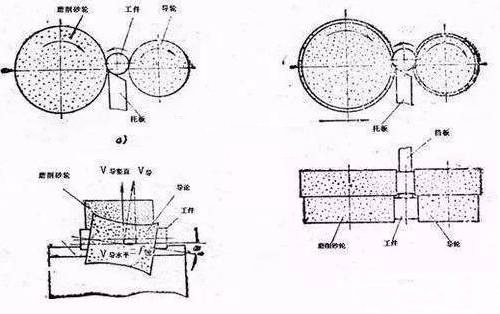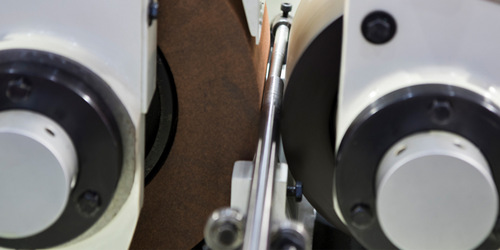Common grinding problems with centerless grinders and their elimination methods are summarized below for your reference!
Parts are not round
Analysis of causes
1. The guide wheel is not rounded
2. The number of grinding operations is few or the ellipse in the previous process is too large.
3. The grinding wheel is dull
4. The amount of grinding is too large or the amount of tool feed is too large

Elimination method
1. Rebuild the guide wheel and wait until the guide wheel is rounded (usually until there is no intermittent sound)
2. Increase the number of grinding appropriately
3.Reshape the grinding wheel
4. Reduce grinding volume and re-tooling speed
The parts have edges (polygons)
Analysis of causes
1. The center of the part is not high enough
2. The axial thrust of the part is too large, causing the part to press against the stop pin and prevent it from rotating evenly.
3. The grinding wheel is unbalanced
4. The center of the part is too high
Elimination method
1. Appropriately increase the center height of the part
2. Reduce the inclination angle of the grinder guide wheel to 0.5° or 0.25°. If it still cannot be solved, check the balance of the fulcrum
3. Balance grinding wheel
4. Properly reduce the center height of the part
Vibration traces on the surface of parts (i.e. fish spots and straight white lines appear on the surface of parts)
Analysis of causes
1. Machine tool vibration Analysis of causesd by unbalanced surface of grinding wheel
2. The center of the part is too high to make the part jump.
3. The grinding wheel is dull or the surface of the grinding wheel is too smooth.
4. The guide wheel rotates too fast
Elimination method
1. Carefully balance the grinding wheel
2. Properly lower the center of the part
3. Appropriately increase the grinding wheel dressing speed
4. Reduce the guide speed appropriately
When parts have taper
Analysis of causes
1. BeAnalysis of causes the busbar of the front guide plate and the guide wheel is too low or the front guide plate is inclined in the direction of the guide wheel, the front part of the part is small.
2. The rear part is small due to the low surface of the rear guide plate and the busbar of the guide wheel or the tilt of the rear guide plate towards the guide wheel.
3. Taper occurs at the front or rear of the part due to the following reasons
a. The grinding wheel is incorrectly dressed and has a taper itself.
b. The surface of the grinding wheel and guide wheel is worn
Elimination method
1. Properly move the front guide plate in and adjust the front guide plate to be parallel to the guide wheel busbar
2. Adjust the guide surface of the rear guide plate to be parallel to the busbar of the guide wheel and on a line.
a. According to the direction of the taper of the part, adjust the angle grinding wheel in the grinding wheel modification
b. Correct or replace the grinding wheel and guide wheel
When the center of the part is large and the ends are small.
Analysis of causes
1. The front and rear guide plates evenly tilt toward the side of the grinding wheel
2. Dress the grinding wheel into a drum shape
Elimination method
1. Adjust the front and rear guide plates
2. Dressing the grinding wheel, the amount of dressing should not be too large each time
There are circular threads on the surface of the part
Analysis of causes
1. The front and rear guide plates protrude from the surface of the guide wheel, so that the parts are scraped by the edge of the guide wheel at the exit or entrance.
2. The support plate is too soft, and the ground cutting is embedded in the bearing surface of the support plate to form protruding burrs, which are carved into threads on the surface of the part.
3. The coolant is not clean and contains chips or sand.
4. Due to the large amount of grinding at the exit, it is scraped by the edge of the grinding wheel.
5. The center of the part is lower than the center of the grinding wheel and the vertical pressure is greater, causing the sand and chips to stick to the support plate.
6. The grinding wheel is dull
7. Too much material is removed from one grinding operation or the grinding wheel is too thick, resulting in extremely fine threads on the surface of the part.
Elimination method
1. Adjust the front and rear guide plates
2. Replace the support plate with smooth surface and higher hardness.
3.Replace coolant
4. Round the edge of the grinding wheel so that the 20mm at the exit of the part will not be ground.
5. Appropriately increase the center height of the part
6. Replace or dress the grinding wheel
7. Appropriately reduce the amount of grinding and slow down the modification speed
Cut off a small piece from the front of the part
Analysis of causes
1. The front guide plate protrudes from the surface of the guide wheel
2. The front faces of the grinding wheel and the guide wheel are not in a straight line and are very different.
3. Grind too much at the entrance
Elimination method
1. Move the front guide back a little
2. Replace or modify the longest one of the two
3. Reduce the amount of grinding at the entrance
 The middle or tail of the part is cut, and the cuts are as follows:
The middle or tail of the part is cut, and the cuts are as follows:
a. The incision is rectangular
Analysis of causes
1. The rear guide plate exceeds the surface of the guide wheel, preventing the rotation of the parts and the continued surface grinding.
2. The rear support pad extends too long and the ground parts do not fall down, which prevents the rotation and advancement of the ground parts.
Elimination method
1. Move the rear guide plate back appropriately
2. Reinstall the support pad
b. The incision is right-angled
Analysis of causes
1. The rear guide plate lags behind the surface of the guide wheel
2. The center of the part is too high, causing the part to jump at the exit
Elimination method
1. Move the rear guide slightly forward
2. Properly reduce the center height of the part
The surface of the parts is not bright enough
Analysis of causes
1. The inclination angle of the guide wheel is too large, causing the parts to be cut too quickly
2. The dressing speed of the grinding wheel is too fast and the surface of the grinding wheel is not fine enough.
3. The guide wheel is trimmed too coarsely
Elimination method
1. Reduce the inclination angle
2. Reduce the dressing speed and dress the grinding wheel from the beginning
3.Rebuild the guide wheel
Note: It is prohibited to open the coolant when the grinding wheel is not running. If the coolant is opened first, in order to prevent the occurrence of malfunctions, the machine should be driven intermittently (i.e. on, off, on, off) until the coolant is emitted from all sides, and then start working.

